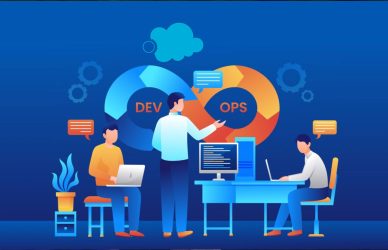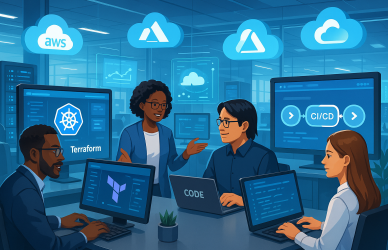ntroduction: Why 2025 Is the Best Year to Enter Cloud Tech
The global cloud computing market is projected to exceed $900 billion by 2025, with companies urgently hiring across roles like Cloud Engineer, DevOps Specialist, Cloud Architect, and Security Analyst.
The surge in multi-cloud deployments and infrastructure automation has created a golden window for job seekers.
Whether you’re coming from IT, software, or switching from a non-tech field, this guide will show you exactly how to land your dream cloud tech job in 2025.
Step 1: Understand the Cloud Engineer Career Path
A cloud computing career typically begins with foundational roles and can progress to architecture, security, or DevOps specialization.
Cloud Career Progression Example:
- Cloud Support Associate
- Junior Cloud Engineer
- DevOps/Infrastructure Engineer
- Senior Cloud Engineer or Architect
- Cloud Consultant or Technical Lead
Each level builds on skills like automation, architecture design, compliance, and performance optimization.
Step 2: Choose a Cloud Platform: AWS vs Azure vs GCP
Each provider has its own ecosystem, certifications, and job demand. Here’s a comparison:
| Platform | Common Roles | Certification Path | Popular Tools |
|---|---|---|---|
| AWS | Solutions Architect, DevOps Engineer | Cloud Practitioner → Solutions Architect → DevOps Pro | EC2, S3, Lambda, CloudFormation |
| Azure | Cloud Administrator, Security Engineer | AZ-900 → Azure Admin → Azure DevOps Engineer | Resource Groups, Bicep, Azure Monitor |
| GCP | Data Engineer, Cloud Developer | Cloud Digital Leader → Associate Cloud Engineer | GKE, BigQuery, Cloud Run, Terraform |
Tip: AWS continues to lead in global demand, Azure is growing fast in enterprises, and GCP dominates in analytics and machine learning.
Step 3: Get Certified with In-Demand Credentials
Certifications show employers that you’re job-ready. Start with entry-level certifications and move toward role-based credentials.
For Beginners:
- AWS Certified Cloud Practitioner
- Microsoft Certified: Azure Fundamentals
- Google Cloud Digital Leader
For Engineers:
- AWS Certified Solutions Architect – Associate
- Azure Administrator Associate
- Google Associate Cloud Engineer
For DevOps & Advanced Roles:
- AWS DevOps Engineer – Professional
- Azure DevOps Engineer Expert
- Google Professional Cloud DevOps Engineer
- Terraform Associate (HashiCorp)
Step 4: Build a Cloud Portfolio that Stands Out
Hiring managers want to see what you can build. Showcase real projects using GitHub and blog posts.
Portfolio Project Ideas:
- Deploy a serverless app on AWS Lambda with API Gateway
- Set up a CI/CD pipeline using GitHub Actions and Terraform
- Create a Kubernetes cluster using GKE and Helm
- Migrate a static website to Azure Blob Storage
- Implement IAM best practices in a mock enterprise setup
Pro Tip: Write a blog post or record a walkthrough video of each project.
Step 5: Master Essential Cloud Skills
Employers expect fluency in both technical and soft skills.
Core Skills:
- Cloud Platforms: AWS, Azure, GCP
- Infrastructure as Code: Terraform, CloudFormation
- CI/CD: GitHub Actions, Jenkins, GitLab CI
- Containers: Docker, Kubernetes
- Monitoring: CloudWatch, Prometheus, Azure Monitor
- Security: IAM, VPC, Key Management, Compliance Tools
Soft Skills:
- Communication across Dev, Ops, and Security teams
- Documentation and incident response
- Agile collaboration and problem-solving
Step 6: Network and Learn from the Cloud Community
A strong community presence gives you access to referrals, mentors, and job leads.
Effective Networking Strategies:
- Attend cloud meetups, webinars, and conferences
- Participate in LinkedIn discussions and share your cloud journey
- Join communities like Reddit (r/devops, r/aws), Discord servers, and Twitter/X spaces
- Contribute to open-source DevOps or cloud infrastructure projects
Remember: 70% of jobs are filled through networking.
Step 7: Start Applying for Cloud Computing Jobs
Once certified and portfolio-ready, begin applying strategically.
Best Job Titles to Search:
- Cloud Support Engineer
- Junior Cloud Engineer
- AWS/Azure/GCP DevOps Engineer
- Cloud Infrastructure Specialist
- Site Reliability Engineer (SRE)
Use www.clouddevopsjobs.com to Find the Right Opportunities
www.clouddevopsjobs.com is your one-stop platform for discovering:
- Remote and hybrid cloud jobs
- Multi-cloud and DevOps roles
- Contract, freelance, and full-time positions
- Jobs filtered by certification and platform
- Resources to optimize your application and resume
Create job alerts, upload your resume, and apply in one click. It’s built for cloud professionals like you.
Final Tips for Landing the Job
- Tailor your resume with cloud-specific keywords
- Create a strong LinkedIn profile aligned with your resume
- Practice mock interviews—especially scenario-based questions
- Track your applications using tools like Trello or Notion
- Stay updated via newsletters from AWS, Azure, and GCP
Conclusion: Your Cloud Career Starts Now
Landing your dream cloud computing job in 2025 is more achievable than ever—if you take action.
The right mix of certifications, skills, hands-on projects, and strategic networking can help you stand out in a competitive job market.
Visit www.clouddevopsjobs.com to explore tailored listings, download resume templates, and begin your journey to becoming a high-impact cloud professional.







